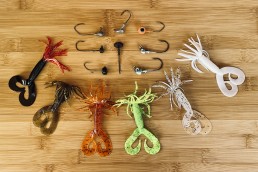Try a Hula Grub This Fall
SHARE THIS POST
No, don’t go searching the back of the closet or storage tubs for those tropical Hawaiian shirts, shorts, and flip-flops; there’s too much of a cold bite in the air for that attire here in the Midwest right now! Instead, let’s look at a bait that has been around for quite some time. Like so many baits, they are hot for a while when they are first released, then just slowly fade away, usually ending up on the shelf along with other baits that have acquired the same status. You certainly won’t get rid of them, but they’re just not part of your regular bait rotation.
Unfortunately, it’s the nature of fishing; we are always in search of the newest, latest, greatest fish-catching baits. They do well for some time, then sort of fizzle out. Some claim that fish become accustomed to certain baits, or that too many anglers are using the same baits and techniques. The reasons vary, but I know I have baits that do no more than take up space on my tackle shelves, seeing very little water time.
But today’s bait is the exception, and honestly when I use this bait, it produces as well as when I tied on my very first plastic morsel many seasons ago. I’ve always called these baits “hula” grubs, probably because my introduction to this style of grub was Gary Yamamoto’s Double Tail Hula Grub. But it’s also called a spider grub by some. Call it what you like, but it was, and in my opinion still is, one of the most effective grub style baits on the market.
The basic design of the bait is a twin-tailed, Twister-type grub, but with tentacles or a skirted addition added to the front of the jig, giving both ends of the jig a very lively action. While not the thumping, loud vibration of other types of plastics like large flapping craws or paddle-tailed offerings, the hula grub has a more subtle tail-swimming action. The front tentacles move not only when the bait is retrieved, but also have a very seductive action when the bait pauses, on the bottom, for example.
I think some of the lack of appeal for this bait is that many anglers limit this bait to a bottom approach—somewhat of a typical jig-and-creature presentation. While it certainly performs great on the bottom, you’re missing many of the fish-catching abilities of this grub by not presenting it in the upper water columns. My original technique consisted of a bottom contact approach for smallmouths, and it was a sensation, but over time I went from bottom hopping and dragging to experimenting with more of a swimbait or steady retrieve, with awesome success as well.
While the hula/spider grub fires up the bite for most of the season, I particularly like the presentation as fall begins the cooling process. Fish are more on the move now with the fall turnover and can be quite unpredictable as to their daily locations. The hula grub allows you to work all the depths with simple retrieve variations, and the subtleness of this bait’s action draws strikes no matter the weather or water conditions.
Are you enjoying this post?
You can be among the first to get the latest info on where to go, what to use and how to use it!
For example, I’ll work this bait starting in the shallows, often as just a slow, steady retrieve, pausing it periodically—especially if hard bottoms exist. In addition, I’ll work the edges of weed lines, or throw the bait near water obstructions, downed trees, large rocks, wood and debris jams on moving water; or work the bait simply as a swimbait, searching through various depths of open water, letting it drop into the depths in search of active fish; or eventually, even slowly crawling the grub along the bottom. With all these capabilities, it’s very clear how this grub becomes such an effective and versatile fall searchbait option.
A multitude of possibilities can be achieved by simply choosing the correct jig or hooking method to alter your presentation. Bottom jigs are always a sure bet: stand-up jigs, football heads, larger Ned heads, round heads—they all work well in various situations. And as mentioned earlier, these baits are extremely effective swimbait offerings, and paired with the proper swimbait style jig heads, are a most effective swimbait technique as the water continues to cool.
The hula/spider grub presentation is an exceptional choice as it can minimize the need for various bait rigs; one style of plastic body and a few different style jigs heads to cover the water depths from top to bottom. Adjust your retrieve to fit the water and seasonal conditions and fall angling success awaits! Get grubbin’!
Looking for some new fishing techniques to try this season? You’ll find plenty of suggestions in every issue of MidWest Outdoors. Subscribe on our website.
MWO
SHARE THIS POST
You may also like...
Nothing found.
Did you enjoy this post?
You can be among the first to get the latest info on where to go, what to use and how to use it!
Dan Brozowski
Passion for angling drives Dan Brozowski to the water’s edge virtually any chance he gets. Although passion cannot be measured, weighed, or recorded, it can be shared. He does this through his writing and while on the water. If you have any questions or comments for Dan, you may contact him at: onthebank@att.net.
